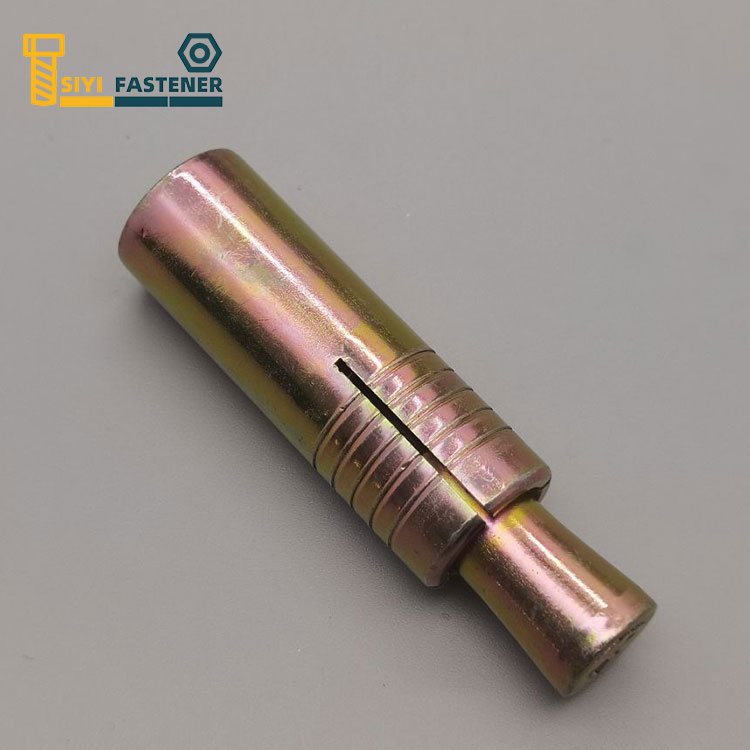Why Are Cut Anchors Becoming the Go-To Fastening Solution?
2025-10-14
Cut anchors are a type of mechanical expansion anchor designed for use in solid base materials such as concrete, natural stone, and solid brick. Their primary function is to create a secure and permanent hold within hard materials by expanding upon installation. The anchor body is typically made from high-strength steel, stainless steel, or carbon steel, providing superior durability, high pull-out resistance, and excellent load-bearing capacity.
The structure of a cut anchor consists of a cone-shaped expansion segment and a cylindrical body with pre-cut slits along the length. When the anchor is inserted into a pre-drilled hole and the bolt or screw is tightened, the cone pulls into the anchor body, forcing the cut sections to expand outward. This expansion grips the walls of the hole firmly, distributing the load evenly and preventing slippage or loosening over time.
Cut anchors are widely used in heavy-duty applications such as machinery installation, railing systems, structural supports, and facade mounting. They are engineered for situations where reliability and stability are critical — particularly in construction environments requiring long-term performance under vibration, tension, and shear forces.
Product Features and Specifications
| Parameter | Description |
|---|---|
| Material Options | Carbon Steel, Stainless Steel (A2 / A4), Zinc-Plated Steel |
| Diameter Range | M6 – M20 |
| Length Range | 40mm – 150mm |
| Head Type | Flat, Hex, or Round Head |
| Working Base Material | Concrete, Solid Brick, Natural Stone |
| Surface Finish | Plain, Hot-Dip Galvanized, or Electroplated Zinc Coating |
| Tensile Strength | 400 – 800 N/mm² depending on size and material |
| Temperature Resistance | Up to 400°C (depending on material grade) |
| Standards | DIN 529, ISO 898, and EN ISO 3506 |
This data illustrates the versatility and mechanical strength of cut anchors. They are not only dimensionally accurate but also manufactured under strict quality standards to ensure uniform expansion and dependable fastening performance.
Why Cut Anchors Are Essential in Modern Construction Projects
In the modern construction landscape, safety, efficiency, and sustainability have become the three pillars guiding material selection. Cut anchors are increasingly preferred due to their consistent performance and structural dependability.
a. Superior Load Distribution
Unlike simple expansion plugs, cut anchors provide uniform stress distribution along the drilled hole. This minimizes the risk of base material cracking — a crucial benefit when working with reinforced concrete or brittle stone.
b. Enhanced Corrosion Resistance
For outdoor and marine applications, stainless steel cut anchors (A4 grade) provide excellent resistance to moisture, chemical exposure, and salt corrosion. This long-lasting protection reduces maintenance costs and extends service life.
c. Time Efficiency and Ease of Installation
Cut anchors require minimal tools for installation. A hammer drill, torque wrench, and standard setting tool are sufficient for precise anchoring. The process is straightforward: drill, clean, insert, and tighten. This simplicity saves installation time, especially in large-scale construction projects.
d. Adaptability for Various Conditions
Whether used for mounting heavy steel beams or securing light fixtures, cut anchors offer flexible performance across a range of substrate conditions. Their design accommodates both tension and shear loads, ensuring reliable hold even under dynamic vibration or temperature fluctuations.
e. Economic Advantage
When compared to chemical anchors, cut anchors are more cost-effective for repetitive or large-scale installations. They don’t require curing time, chemical cartridges, or strict temperature conditions, making them ideal for fast-paced projects.
How to Choose, Install, and Maintain Cut Anchors
a. Selection Guidelines
Choosing the right cut anchor depends on several factors, including base material type, load requirements, and environmental exposure. For instance, stainless steel variants are recommended for outdoor or wet environments, while zinc-plated steel is suitable for indoor applications.
b. Step-by-Step Installation Process
-
Drill the Hole: Use a hammer drill with the correct diameter bit (equal to the anchor size).
-
Clean the Hole: Remove debris and dust using compressed air or a brush.
-
Insert the Anchor: Gently tap the anchor into the hole until it sits flush with the surface.
-
Set the Expansion: Tighten the bolt or nut to pull the internal cone, expanding the anchor body into the concrete.
-
Verify Tightness: Use a calibrated torque wrench to ensure the correct tightening torque for the specific anchor size.
c. Maintenance and Inspection
Although cut anchors are largely maintenance-free, periodic inspection is recommended for structures subject to vibration or environmental stress. Check for corrosion, deformation, or loosening during routine structural maintenance cycles.
d. Common Installation Mistakes to Avoid
-
Drilling holes too wide or shallow
-
Not cleaning dust or debris before insertion
-
Over-tightening or under-tightening the bolt
-
Using the wrong anchor size for the load requirement
Following proper installation techniques ensures optimal load transfer and long-term reliability.
Future Trends, Market Outlook, and FAQs about Cut Anchors
a. The Future of Cut Anchors in Construction Technology
As the construction industry embraces automation, sustainability, and smart materials, cut anchors are evolving to meet higher safety and environmental standards. Manufacturers are developing eco-friendly coatings, higher-grade corrosion-resistant alloys, and precision-engineered expansion geometries to enhance grip efficiency.
Emerging innovations also include digital torque monitoring systems for anchor installation verification — ensuring that every anchor meets exact torque specifications, especially in high-risk infrastructure projects such as bridges and power plants.
The demand for smart fasteners — those embedded with RFID chips or load sensors — is another rising trend. These allow real-time monitoring of anchor tension, providing valuable data for predictive maintenance in modern infrastructure management.
b. Market Perspective
According to recent industrial reports, the global market for mechanical anchors, including cut anchors, is projected to grow steadily over the next decade. Factors such as rapid urbanization, increased infrastructure investment, and stricter safety standards drive this growth. Asia-Pacific and Europe remain the leading consumers, while North America continues to show strong adoption due to industrial renovation and energy projects.
Common Questions About Cut Anchors
Q1: What is the difference between a cut anchor and an expansion anchor?
A cut anchor is a specific type of expansion anchor designed with pre-cut slits that allow the body to expand more precisely when tightened. This controlled expansion provides superior grip and load distribution compared to general expansion anchors, making them ideal for high-strength applications like machinery and structural installations.
Q2: Can cut anchors be reused after removal?
Generally, cut anchors are not recommended for reuse. Once the anchor expands inside the drilled hole, the material deformation prevents it from returning to its original shape. Removing and reinstalling may compromise holding strength and safety. For critical applications, always use a new anchor to ensure full performance.
The Reliable Choice for Long-Term Structural Security
Cut anchors continue to be an integral part of modern fastening systems, offering unmatched stability, durability, and ease of installation. Their engineered precision and load-bearing efficiency make them indispensable across construction, industrial, and civil engineering projects. With growing demands for sustainable and intelligent infrastructure, the future of cut anchors points toward enhanced material science and digital integration for performance verification.
As a trusted manufacturer, NINGBO Siyi Fastener specializes in producing high-quality cut anchors that meet international standards and offer consistent performance under all conditions. Each product undergoes rigorous testing to ensure compliance, precision, and reliability — guaranteeing customers the highest level of fastening security.
For technical specifications, custom sizes, or bulk orders, contact us today to discover how NINGBO Siyi Fastener can support your next project with dependable anchoring solutions that stand the test of time.



